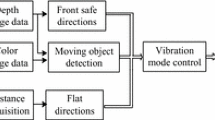Abstract
Many aids have been proposed for the visually impaired or the blind. The regular cane is widely accepted but has known limitations such as a small perceptual range constraint by its short length. Numerous approaches such as ultrasound enhanced canes have been developed with limited success, the main reason being the information transfer over the auditory system, one of the most important spatial senses.
It is proposed to use fast 3D object recognition in conjunction with a priority based information reduction as used in autonomous mobile robotics to generate a virtual velocity map of objects in the surrounding. This information shall be transferred to the cognitive system of the blind via the stimulation of skin receptors. Here we report on the evaluation of a special belt to communicate object locations and velocities to subjects.
An elastic belt was designed to integrate up to 15 vibration motors as used in mobile phones. Currently up to 8 motors can be controlled simultaneously via a parallel port of a PC. The direction towards an object is coded by the location of the motor in the belt (local coding). Velocity information is transferred to the person by a pulse coding scheme.
Non-handicapped students were involved as study objects to determine perception thresholds and accuracy of perception. In a first step the subjects were facing a forced choice test to optimize the individual perception thresholds. In a second trial position and strength of signal coding were evaluated.
Position information was correctly identified by the subjects within 15 degrees. Pulse frequency in the range of 0.1Hz to 2 Hz could be perceived strongly and were distinguishable.
The strength of the vibration and its location could be used for spatial orientation. This “vibration information” can be used by the subject to make assumptions about approaching objects.
Access this chapter
Tax calculation will be finalised at checkout
Purchases are for personal use only
Preview
Unable to display preview. Download preview PDF.
Similar content being viewed by others
References
P. Bach-y-Rita, K. A. Kaczmarek, M. E. Tyler, and M. Garcia-Lara. Form perception with a 49-point electrotactile stimulus array on the tongue: A technical note. Journal of Rehabilitation Research and Development, 1998:427–430, 35
Bach-y-Rita P. Tactile Sensory Substitution Studies Ann. N.Y. Acad. Sci. 1013: 83–91 (2004).
Bostelman R, Russo P, Albus J, Hong T, Madhavan R., “Applications of a 3D range camera towards healthcare mobility aids.”, Proceedings of the 2006 IEEE International Conference on Networking, Sensing and Control, pp. 416–21, 2006.
Bouzit, M. et.al., “Tactile Feedback navigation handle for the visually impaired”, Proceedings of IMECE2004 2004 ASME International Mechanical Engineering Congress and RD&D Expo November 13–19, 2004, Anaheim, California USA
van Erp, J. B. F., Presenting directions with a vibrotactile torso display. Ergonomics, 48(3):302–313, 2005.
J. Schneider, T. Strothotte, „Constructive exploration of spatial information by blind users“, In: Proceedings of the fourth international ACM conference on Assistive technologies, Arlington, USA, 2000.
Author information
Authors and Affiliations
Corresponding author
Editor information
Editors and Affiliations
Rights and permissions
Copyright information
© 2009 Springer-Verlag Berlin Heidelberg
About this paper
Cite this paper
Möller, K. et al. (2009). AERBUS: Enhanced perception of the environment for visually impaired people. In: Vander Sloten, J., Verdonck, P., Nyssen, M., Haueisen, J. (eds) 4th European Conference of the International Federation for Medical and Biological Engineering. IFMBE Proceedings, vol 22. Springer, Berlin, Heidelberg. https://doi.org/10.1007/978-3-540-89208-3_386
Download citation
DOI: https://doi.org/10.1007/978-3-540-89208-3_386
Publisher Name: Springer, Berlin, Heidelberg
Print ISBN: 978-3-540-89207-6
Online ISBN: 978-3-540-89208-3
eBook Packages: EngineeringEngineering (R0)




